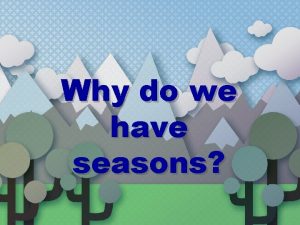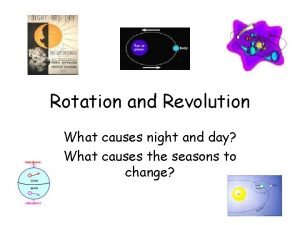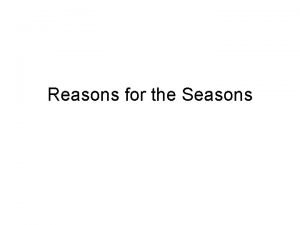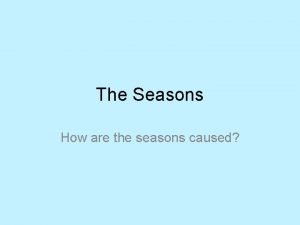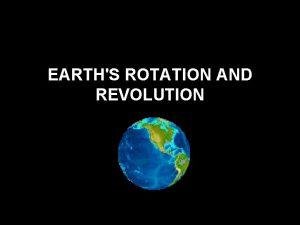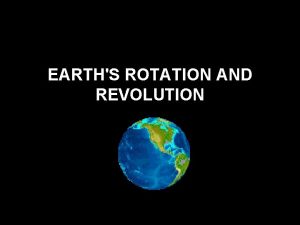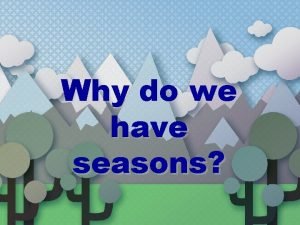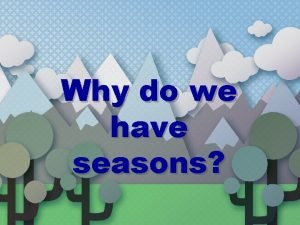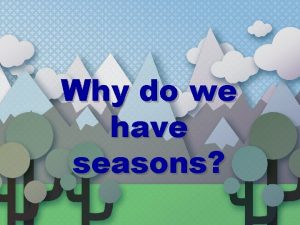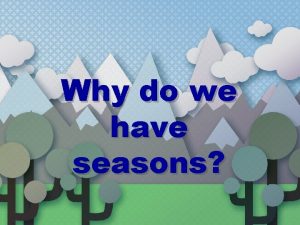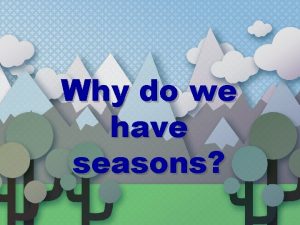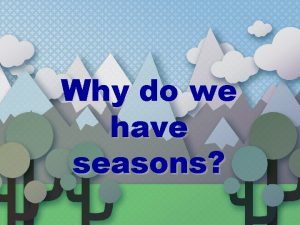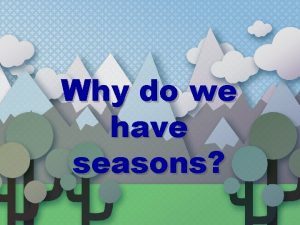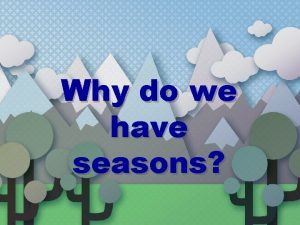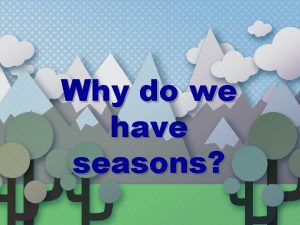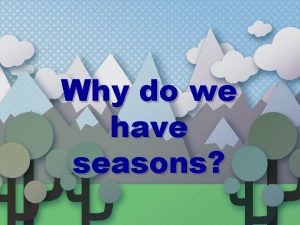Why do we have seasons Earths rotation The



















- Slides: 19

Why do we have seasons?

Earth’s rotation • The Earth rotates on its axis (imaginary vertical line around which Earth spins) every 23 hours & 56 minutes. • Day on Earth is when our side of the Earth faces the sun. • Night on Earth is when the side of Earth we are on faces away from the sun.

Earth’s revolution • It takes the Earth 365 days and 6 hours (or rotations) to travel or revolve around the Sun once. • This is called a year!

Why do we have seasons? • Seasons are not caused by how close the Earth is to the sun. • In fact, the Earth is closest to the sun around January 3 and farthest away from the sun around July 4. Ellipse

When is the Earth closest to the sun?

When is the Earth closest to the sun? • January

The Tilting… • Seasons are the result of the tilt of the Earth's axis. • Earth’s axis is tilted at 23. 5°.

• Summer is warmer than winter (in each hemisphere) because the Sun's rays hit the Earth at a more direct angle during summer than during winter.

• During the winter, the Sun's rays hit the Earth at an extreme angle, and the days are very short. These effects are due to the tilt of the Earth's axis.

Seasons…Northern Hemisphere

http: //www. nmm. ac. uk/uploads/gif/seasons-full. gif

Solstice and Equinox…

Solstices • Solstices occur twice a year, when the tilt of the Earth's axis is oriented directly towards or away from the Sun, causing the Sun to appear to reach its northernmost and southernmost extremes.

SOLSTICE - Summer • This occurs approximately on June 21 st. • This day has the longest about of sunlight as any day during the year.

SOLSTICE • During the summer solstice, the North Pole has 24 hours of daylight and the South Pole has 24 hours of darkness. • During the winter solstice, the North Pole has 24 hours of darkness and the South Pole has 24 hours of daylight.

SOLSTICE - Winter • This occurs approximately on December 21 st. • This day has the least about of sunlight as any day during the year.

Equinox • Halfway between each solstice, daylight and nighttime are equal. This is called the equinox. • There is one for spring (vernal equinox) and one for autumn (autumnal equinox).

Equinox • The daylight lasts 12 hours and a night lasts 12 hours at all latitudes. • Equinox literally means "equal night". • Sunlight strikes the earth most directly at the equator.

Equinox • The vernal (spring) equinox occurs March 21. • The autumnal (fall) equinox occurs September 21.
 Earths orbit seasons
Earths orbit seasons What causes seasons rotation or revolution
What causes seasons rotation or revolution Why do we have seasons
Why do we have seasons What causes night and day
What causes night and day There are four seasons all over the world true or false
There are four seasons all over the world true or false Why why why why
Why why why why How to calculate specific rotation of a mixture
How to calculate specific rotation of a mixture Why do we experience seasons
Why do we experience seasons Whats causes seasons
Whats causes seasons Months of spring
Months of spring Why do we experience seasons
Why do we experience seasons The bluest eye motifs
The bluest eye motifs The earths layer foldable
The earths layer foldable Earths roation
Earths roation Whats a natural satellite
Whats a natural satellite Earths biomes
Earths biomes Periodic table of elements families
Periodic table of elements families Basalt
Basalt Whats earths moon called
Whats earths moon called Which layer of the earth slowly moves like putty
Which layer of the earth slowly moves like putty

